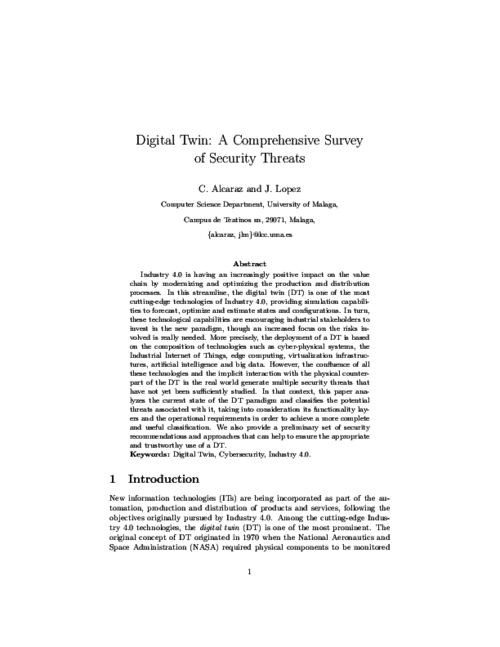 ]
] 5th Intern. Conf. on Computer Aided Systems Theory and Technology (EUROCAST’97), pp. 183-189, February, 1997.
Abstract
This paper is a first approach to the use of artificial neural networks as a tool to estimate the orientation of an object, and is mainly directed towards industrial applications. The capability of neural networks to generalise is a key element in the calculation of an object’s orientation. In this sense, a neural network can identify the angle of a part never seen before. To evaluate the efficiency of this method we have performed a series of tests with the different parts used in a car assembly line.
IEEE International Workshop on Electronic Government (in DEXA’00), IEEE Press, pp. 362-365, 2000.
Revista SIC: Seguridad en Informática y Comunicaciones, vol. 38, pp. 1-5, 2000.
11th International Conference on Database and Expert Systems Applications (DEXA’00), LNCS 1873, Springer, pp. 929-938, September, 2000.
Abstract
Public-key cryptography is fast becoming the foundation for those applications that require security and authentication in open networks. But the widespread use of a global public-key cryptosystem requires that public-key certificates are always available and up-to-date. Problems associated to digital certificates management, like storage, retrieval, maintenance, and, specially, revocation, require special procedures that ensure reliable features because of the critical significance of inaccuracies. Most of the existing systems use a Certificate Revocation List, a repository of certificates that have been revoked before their expiration date. The need to access CRLs in order to check certificate revocations becomes a performance handicap. Furthermore, they introduce a source of vulnerability in the whole security infrastructure, as it is impossible to produce a new CRL each time a revocation takes place. This paper introduces an alternative for the storage of digital certificates that avoids the use of CRLs. The system is designed to provide a distributed management of digital certificates by using Certification Authorities that, while being part of a whole Public-Key Infrastructure, operate over local certificates databases. Communication protocols between local databases have been designed to minimize network traffic without a lack of security and efficiency.
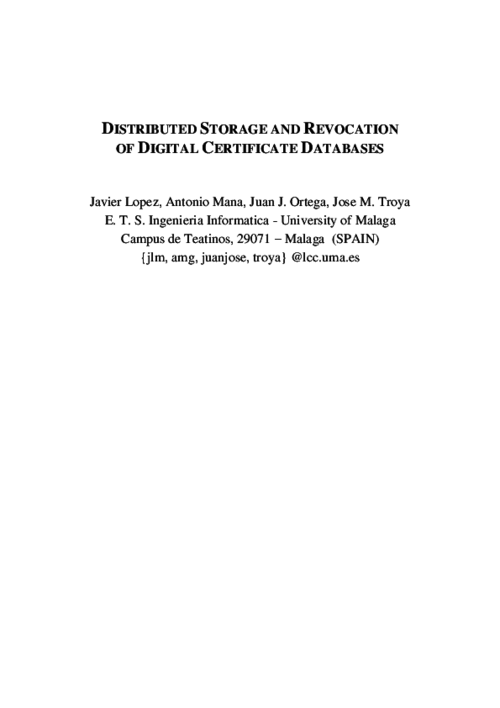
International Conference on Infrastructure Security (InfraSec’02), LNCS 2437, Springer-Verlag, pp. 325-337, October, 2002.
Abstract
The main aims of Virtual Private Network (VPN) are to isolate a distributed network from outsiders, as well as to protect the confidentiality and integrity of sensitive information traversing a non-trusted network such as the Internet. However, some problems arise when security is considered as the unique problem because VPN users suffer from restrictions in their access to the network. They are not free to use traditional Internet services such as electronic mail exchange with non-VPN users, and to access Web and FTP servers external to the organization. This paper presents a new solution that allows the open use of traditional network services running over TCP and UDP layers, while maintaining strong security features. The new scheme works at the TCP/IP transport layer and does not require the addition of new hardware because it is a totally software solution. As a consequence, the application is totally portable. Moreover, and because of its implementation at the transport layer, there is no need to modify any traditional communication applications previously installed in the network system.

3rd ACIS Int. Conf. on Software Engineering, Artificial Intelligence Networking and Parallel/Distributed Computing (SNPD’02), pp. 157-163, Junio, 2002.
Abstract
Interaction of organizations and their clients by using the Internet can produce meaningful benefits in the accessibility, efficiency and availability of documents, regardless of time and location. However, some types of problems hinder a higher degree of communication. This paper presents some of the results of a Research Project that focuses on the influence of typical open networks risks in electronic interactions and on the need of creating software tools to manage electronic versions of the paper-based forms, as this is the traditional way of interaction through the Web.
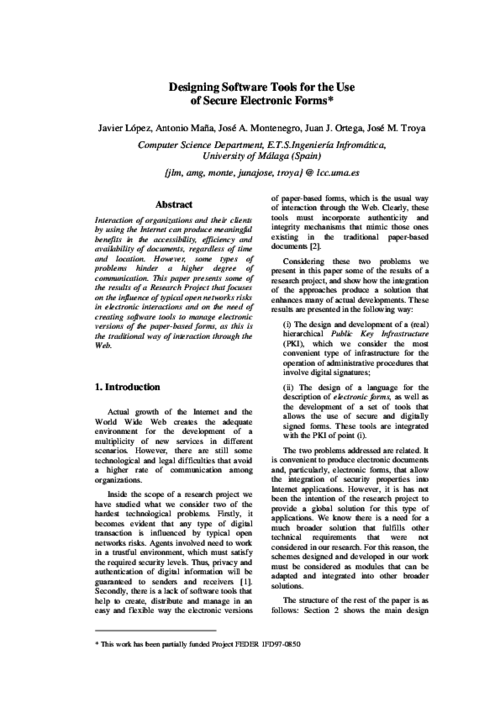
VIII Reunión Española sobre Criptología y Seguridad de la información (VIII RECSI),Madrid, pp. 571-581, Septiembre, 2004.
Abstract
Este trabajo muestra los detalles de una implementacion prototipo del marco de trabajo de Certificados de Atributos X.509 (Xac), propuesto por la recomendacion ITU-T. La implementacion utiliza como base de la plataforma la librer
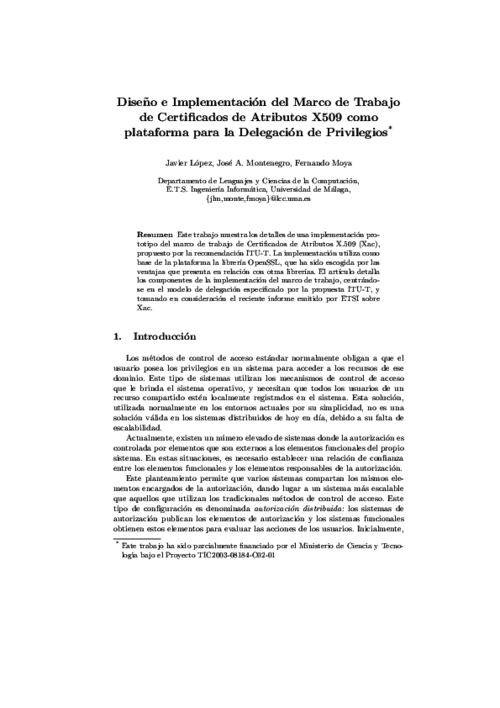
Fifth International Network Conference (INC’05), pp. 157-164, 2005.
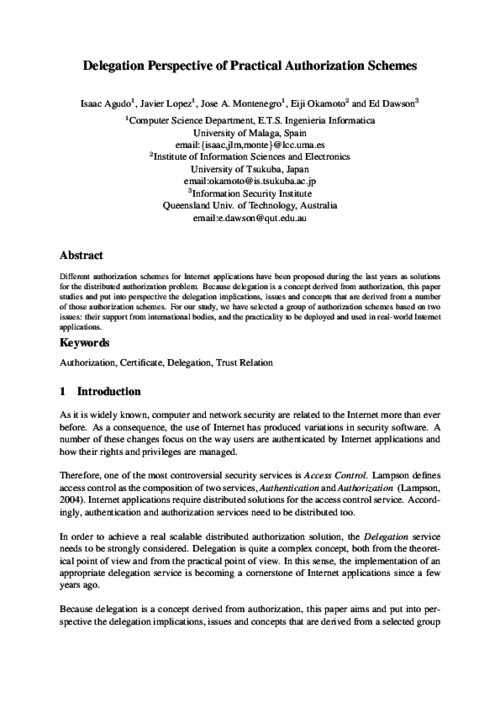
Information Security Technical Report, vol. 12, no. 3, Elsevier, pp. 139-147, Jun 2007. DOI
Abstract
This paper explains the evolution of the concept of delegation since its first references in the context of distributed authorization to the actual use as a fundamental part of a privilege management architecture. The work reviews some of the earliest contributions that pointed out the relevance of delegation when dealing with distributed authorization, in particular we comment on PolicyMaker and Keynote, and also on SDSI/SPKI. Then, we elaborate on Federation as a particular case of delegation, and remark the importance given to federation by the industry. Finally, the paper discusses about privilege management infrastructures, introducing a new mechanism to extend their functionality using advanced delegation services.
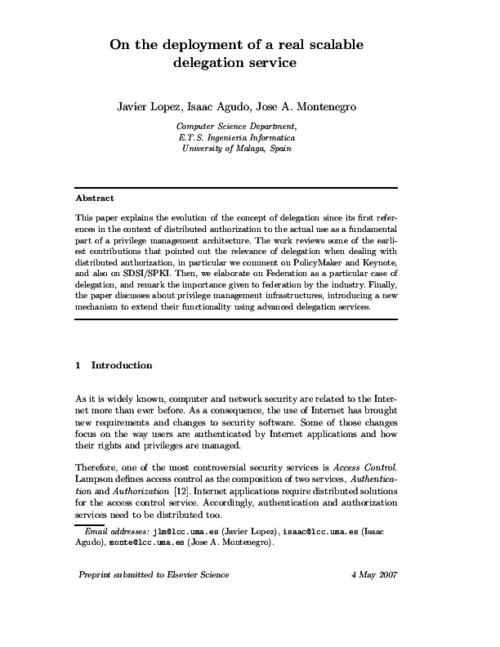
5th International Workshop on Formal Aspects in Security and Trust (FAST’08), LNCS 5491, Springer, pp. 302-315, 2008. DOI
Abstract
When delegation in real world scenarios is considered, the delegator (the entity that posses the privileges) usually passes the privileges on to the delegatee (the entity that receives the privileges) in such a way that the former looses these privileges while the delegation is effective. If we think of a physical key that opens a door, the privilege being delegated by the owner of the key is opening the door. Once the owner of the key delegates this privilege to another entity, by handing over the key, he is not able to open the door any longer. This is due to the fact that the key is not copied and handed over but handed over to the delegatee. When delegation takes place in the electronic world, the delegator usually retains also the privileges. Thus, both users have them simultaneously. This situation, which in most cases is not a problem, may be undesirable when dealing with certain kind of resources. In particular, if we think of finite resources, those in which the number of users accessing simultaneously is finite, we can not allow that a user delegating his access privilege is also granted access when the delegation if effective. In this paper we propose an approach where each user is delegated an access quota for a resource. If further delegating of the delegated quota occurs, this is subtracted from his quota. That is, when delegating, part of the quota remains with the delegator and another part goes to the delegatee. This allows a more fairly access to the resource. Moreover, we show that this approach can also be applied to any kind of resources by defining appropriate authorization policies.
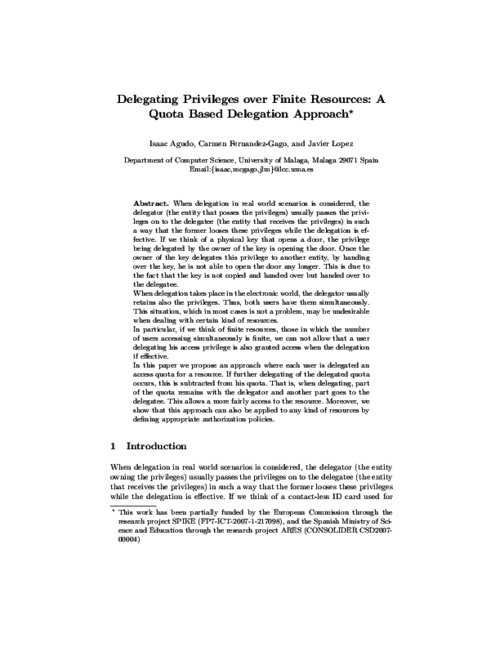
3rd CompanionAble Workshop - Future Internet of People, Things and Services (IoPTS) eco-Systems, xxxx, pp. xxxx, December, 2009.
Abstract
Wireless sensor networks are considered as an integral part of the Internet of Things paradigm. Not only they provide a virtual presence to elements of the real world, but also allow any computationalsystem to know about the physical state of those elements thanks to the use of embedded sensors. In order to belong to the Internet of Things, the elements of a sensor network can implement Internet protocols and services such as the TCP/IP stack and web services. Still, a question that must be raised at this point of time is whether all sensor network applications should be completely integrated into the Internet or not. The purpose of this paper is to analyze this question, reviewing the challenges and security requirements of Internet-enabled sensor networks.

Journal of Universal Computer Science, vol. 16, no. 17, Springer, pp. 2333-2352, Sep 2010. DOI
Abstract
The idea of developing software through systematic development processes toimprove software quality is not new. Nevertheless, there are still many information systemssuch as those of Grid Computing which are not developed through methodologies that areadapted to their most differentiating features. A systematic development process for Gridsystems that supports the participation of mobile nodes and incorporates security aspects intothe entire software lifecycle will thus play a significant role in the development of systemsbased on Grid computing. We are creating a development process for the construction ofinformation systems based on Grid Computing, which is highly dependent on mobile devices,in which security plays a highly important role. One of the activities in this process is that ofanalysis which is focused on ensuring that the system’s security and functional requirements areelicited, specified and modelled. In our approach, this activity is driven by use cases andsupported by the reusable repository. This obtains, builds, defines and refines the use cases ofthe secure Mobile Grid systems which represent the functional and non-functional requirementsof this kind of systems. In this paper, we present the proposed development process throughwhich we introduce the main aspects of the UML profile defined for building use case diagramsin the mobile Grid context through which it is possible to represent specific mobile Gridfeatures and security aspects, showing in detail how to build use case diagrams for a real mobile Grid application by using our UML profile, denominated as GridUCSec-Profile.
IEEE International Conference on Cloud Computing Technology and Science (CloudCom 2014), IEEE, pp. 374-379, 12/2014. DOI
Abstract
Among Big Data technologies, Hadoop stands out for its capacity to store and process large-scale datasets. However, although Hadoop was not designed with security in mind, it is widely used by plenty of organizations, some of which have strong data protection requirements. Traditional access control solutions are not enough, and cryptographic solutions must be put in place to protect sensitive information. In this paper, we describe a cryptographically-enforced access control system for Hadoop, based on proxy re-encryption. Our proposed solution fits in well with the outsourcing of Big Data processing to the cloud, since information can be stored in encrypted form in external servers in the cloud and processed only if access has been delegated. Experimental results show that the overhead produced by our solution is manageable, which makes it suitable for some applications.
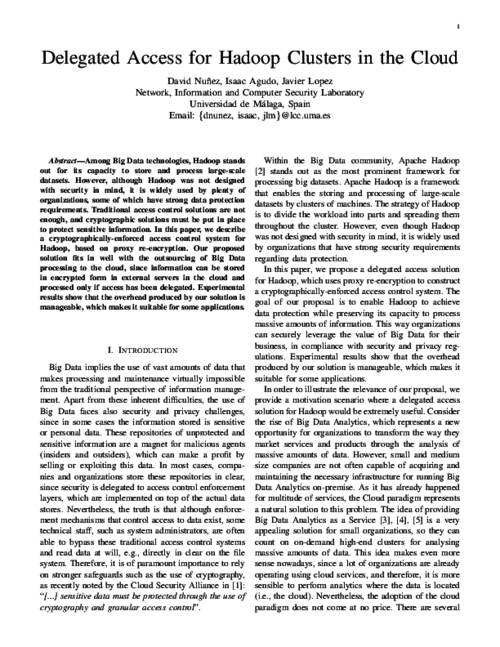
Computer Standards & Interfaces, vol. 36, issue 3, Elsevier, pp. 501-512, 2014. DOI
Abstract
Situational awareness for critical infrastructure protection, such as for energy control systems, has become a topic of interest in recent years. Despite attempts to address this area of research, more progress is still necessary to find attractive solutions that help bring about prevention and response at all times from anywhere and at any time. Given this need, we therefore propose in this paper, a smart mechanism able to offer a wide-area situational awareness with the ability to: (i) Control the real state of the observed infrastructure, (ii) respond to emergency situations and (iii) assess the degree of ccuracy of the entire control system. To address these aspects, the mechanism is based on a hierarchical configuration of industrial sensors for control, the ISA100.11a standard for the prioritization and alarm management, and the F-Measure technique to study the level of accuracy of a sensor inside a neighbourhood. As proof of the functionality and feasibility of the mechanism for critical contexts, a software application implemented in nesC and Java is also presented in this paper.
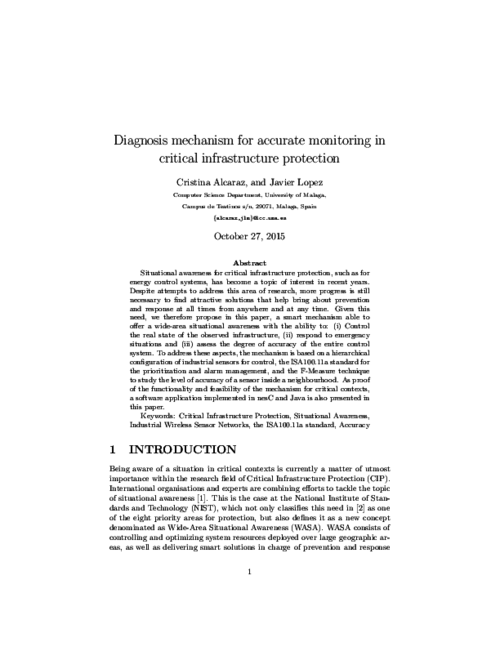
ERCIM News, no. 106, ERCIM EEIG, pp. 9-9, 07/2016.
IEEE Network, IEEE Communications Society, pp. 12-19, 2016. DOI
Abstract
Personal devices contain electronic evidence associated with the behaviour of their owners and other devices in their environment, which can help clarify the facts of a cyber-crime scene. These devices are usually analysed as containers of proof. However, it is possible to harness the boom of personal devices to define the concept of digital witnesses, where personal devices are able to actively acquire, store, and transmit digital evidence to an authorised entity, reliably and securely. This article introduces this novel concept, providing a preliminary analysis on the management of digital evidence and the technologies that can be used to implement it with security guarantees in IoT environments. Moreover, the basic building blocks of a digital witness are defined.
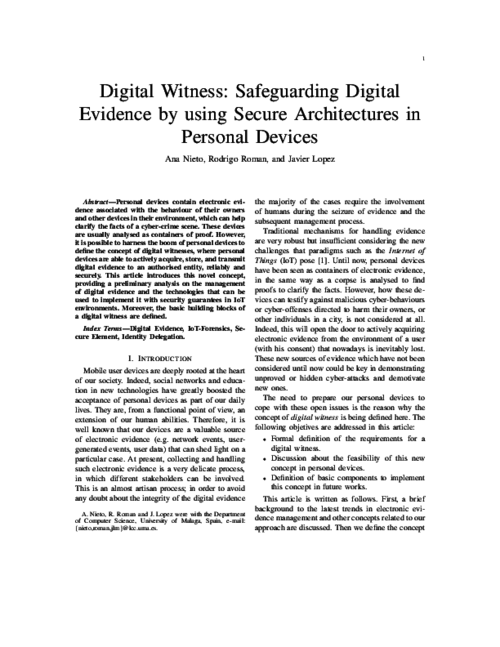
Proceedings of the 13th International Joint Conference on e-Business and Telecommunications (SECRYPT 2016), pp. 19-27, 2016. DOI
Abstract
Increasingly, automatic restoration is an indispensable security measure in control systems (e.g. those used in critical infrastructure sectors) due to the importance of ensuring the functionality of monitoring infrastructures. Modernizing the interconnection of control systems to provide interoperability between different networks, at a low cost, is also a critical requirement in control systems. However, automated recovery mechanisms are currently costly, and ensuring interoperability particularly at a low cost remains a topic of scientific challenge. This is the gap we seek to address in this paper. More specifically, we propose a restoration model for interconnected contexts, taking into account the theory of supernode and structural controllability, as well as the recommendations given by the IEC-62351-8 standard (which are mainly based on the implementation of a role-based access control system).
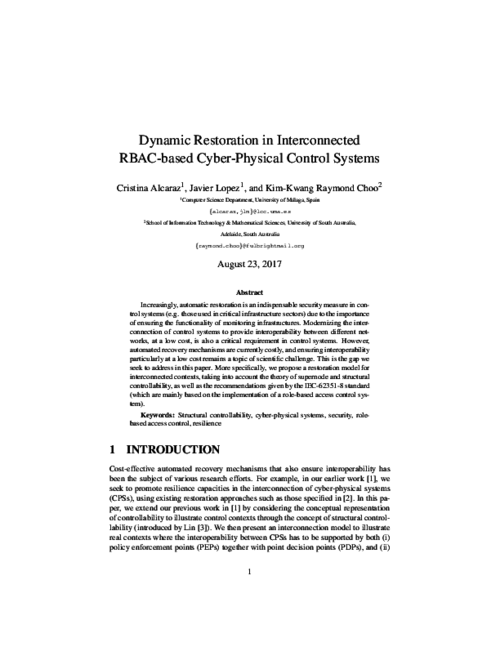
16th IEEE International Conference On Trust, Security And Privacy In Computing And Communications (TrustCom 2017), IEEE, pp. 642-649, 08/2017. DOI
Abstract
The digital witness approach defines the collaboration between IoT devices - from wearables to vehicles - to provide digital evidence through a Digital Chain of Custody to an authorised entity. As one of the cores of the digital witness, binding credentials unequivocally identify the user behind the digital witness. The objective of this article is to perform a critical analysis of the digital witness approach from the perspective of privacy, and to propose solutions that help include some notions of privacy in the scheme (for those cases where it is possible). In addition, digital anonymous witnessing as a tradeoff mechanism between the original approach and privacy requirements is proposed. This is a clear challenge in this context given the restriction that the identities of the links in the digital chain of custody should be known.

IEEE Systems Journal, vol. 11, issue 4, no. 99, IEEE, pp. 2479-2489, 12/2017. DOI
Abstract
The growing number of parameters in heteroge- neous networks, as is the case of the fifth generation (5G) Green networks, greatly complicates the analysis of the Security and Quality of Service Tradeoff (SQT). However, studying these types of relationships is crucial in Future Internet scenarios to prevent potential points of failure and to enhance the use of limited resources, increasing the user’s experience. Therefore, it is fundamental to provide tools and models for training, so that the users understand these dependencies and solve them prior to deploying new solutions. In this paper, a Recommendation System for SQT (SQT-RS) is deployed in 5G Green systems, considering the particular case of relay networks and the impact of eavesdropping and jamming contexts on the models generated by the user, aided by SQT-RS. With this goal in mind, we provide a component for the user to automatically select specific contexts based on 5G Green capabilities.
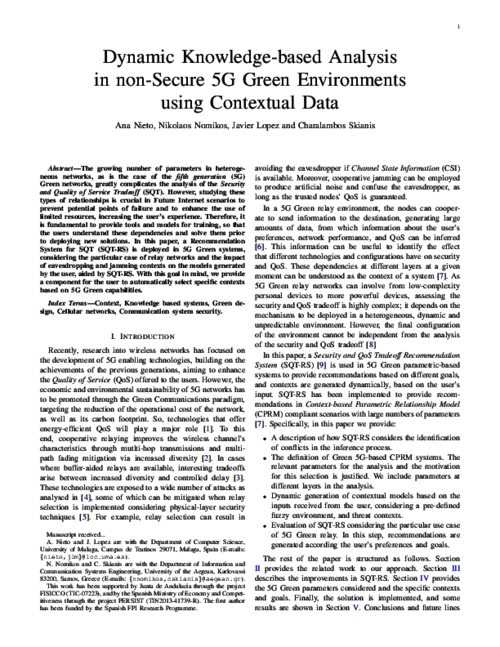
XV Reunión Española sobre Criptología y Seguridad de la Información, 10/2018.
Abstract
Con la revolución tecnológica que ha supuesto la Internet de las Cosas (Internet of Things, IoT) se han presentado escenarios donde la preocupación por la seguridad en dicho entorno es cada vez más relevante. Están comenzando a surgir vulnerabilidades en varios dispositivos, y los sistemas trampa son una excelente manera de lidiar con este problema. En este trabajo se analizan soluciones para honeypots en el entorno IoT (y en otros que se puedan adaptar) para sentar las bases de una metodología que permita el despliegue de honeypots IoT.
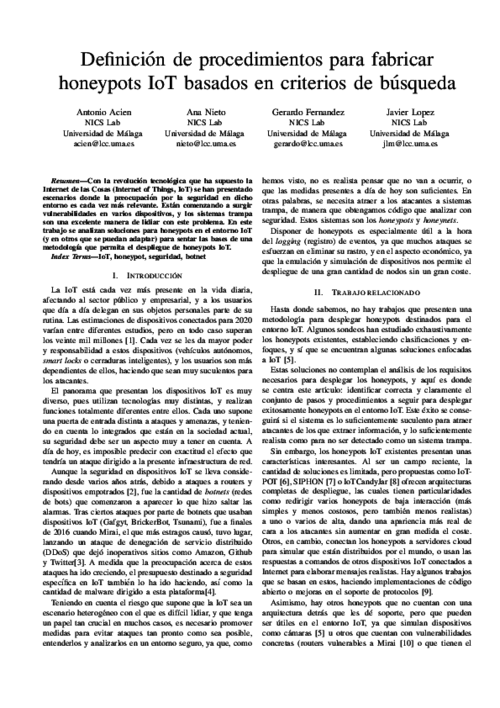
IEEE Systems Journal, vol. 13, issue 1, IEEE, pp. 238 - 247, 03/2019.
25th European Symposium on Research in Computer Security (ESORICS 2020), vol. 12308, pp. 174-192, 09/2020. DOI
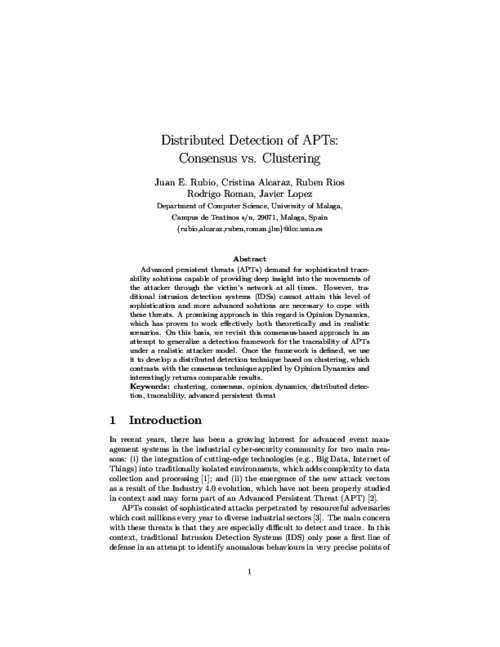
IEEE Wireless Communications, vol. 28, issue 2, IEEE, pp. 48-55, 04/2021. DOI
Abstract
Beyond fifth generation (B5G) communication networks and computation paradigms in the edge are expected to be integrated into power grid infrastructures over the coming years. In this sense, AI technologies will play a fundamental role to efficiently manage dynamic information flows of future applications, which impacts the authorization policies applied in such a complex scenario. This article studies how digital twins can evolve their context awareness capabilities and simulation technologies to anticipate faults or to detect cyber-security issues in real time, and update access control policies accordingly. Our study analyzes the evolution of monitoring platforms and architecture decentralization, including the application of machine learning and blockchain technologies in the smart grid, toward the goal of implementing autonomous and self-learning agents in the medium and long term. We conclude this study with future challenges on applying digital twins to B5G-based smart grid deployments.
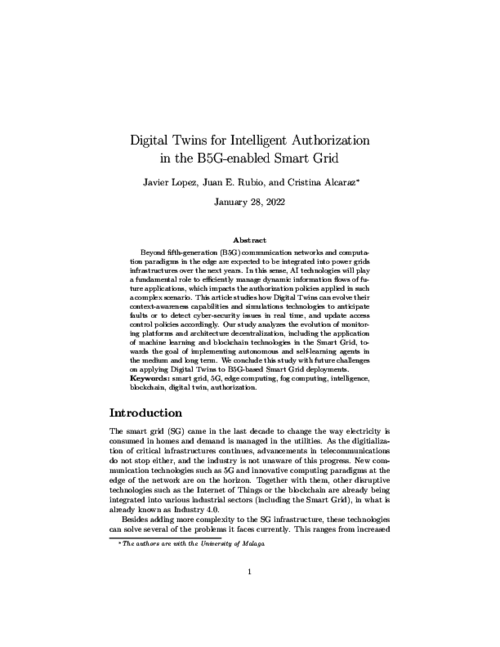
IEEE Communications Surveys & Tutorials, vol. 24, issue 3, no. thirdquarter 2022, IEEE, pp. 1475 - 1503, 04/2022. DOI
Abstract
Industry 4.0 is having an increasingly positive impact on the value chain by modernizing and optimizing the production and distribution processes. In this streamline, the digital twin (DT) is one of the most cutting-edge technologies of Industry 4.0, providing simulation capabilities to forecast, optimize and estimate states and configurations. In turn, these technological capabilities are encouraging industrial stakeholders to invest in the new paradigm, though an increased focus on the risks involved is really needed. More precisely, the deployment of a DT is based on the composition of technologies such as cyber-physical systems, the Industrial Internet of Things, edge computing, virtualization infrastructures, artificial intelligence and big data. However, the confluence of all these technologies and the implicit interaction with the physical counterpart of the DT in the real world generate multiple security threats that have not yet been sufficiently studied. In that context, this paper analyzes the current state of the DT paradigm and classifies the potential threats associated with it, taking into consideration its functionality layers and the operational requirements in order to achieve a more complete and useful classification. We also provide a preliminary set of security recommendations and approaches that can help to ensure the appropriate and trustworthy use of a DT.
